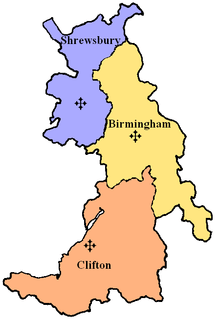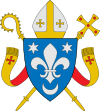Roman Catholic Diocese of Clifton
| Diocese of Clifton Dioecesis Cliftoniensis | |
|---|---|
 Symbol of the Diocese of Clifton | |
| Location | |
| Country | England |
| Territory | Counties of Gloucestershire, Somerset and Wiltshire and the Greater Bristol Area |
| Ecclesiastical province | Province of Birmingham |
| Metropolitan | Birmingham |
| Coordinates | 51°27′22″N 2°36′58″W / 51.456°N 2.616°W |
| Statistics | |
| Area | 10,912 km2 (4,213 sq mi) |
| Population - Total - Catholics |
(as of 2013) 2,137,000 199,900 (9.4%) |
| Parishes | 107 |
| Information | |
| Denomination | Roman Catholic |
| Rite | Latin Rite |
| Established | 29 September 1850 |
| Cathedral | Clifton Cathedral |
| Secular priests | 128 |
| Current leadership | |
| Pope | Francis |
| Bishop | Declan Ronan Lang |
| Metropolitan Archbishop | Bernard Longley |
| Vicar General |
|
| Episcopal Vicars |
|
| Map | |
 Diocese of Clifton within the Province of Birmingham | |
| Website | |
| cliftondiocese.com | |
The Roman Catholic Diocese of Clifton is a Roman Catholic diocese centred on the Cathedral Church of Saints Peter and Paul in Clifton, England.
The diocese covers the City and County of Bristol and the ceremonial counties of Gloucestershire, Somerset, and Wiltshire, an area of 4,215 square miles (10,920 km2). Thus it stretches from Stow in the Wold in the north to Minehead and Watchet in the South. The most north-westerly parishes are in the Forest of Dean, while Marlborough near Swindon is one of the most easterly. The City of Bristol, of which Clifton is a suburb, is the largest centre of population within the Diocese; Swindon is the next biggest. Other well-known cities and towns include Bath, Wells, Cheltenham, Gloucester, Salisbury, Taunton and Weston-super-Mare.
The Clifton Diocese makes up part of the Catholic Association Pilgrimage. It has more regularly scheduled Sunday Masses celebrated in the extraordinary form of the Roman Rite (sometimes known as the Tridentine Mass) within its boundaries than any other diocese in England and Wales.[1]
Statistics
The Diocese has 107 Parishes, or the equivalent. Many have chapels-of-ease or other Mass centres, adding a total of 99 chapels. The parishes are run by a mixture of Diocesan priests, and priests who belong to Religious Orders such as the Benedictines, Franciscans and others.
Diocesan boundaries
The diocese is divided into 13 deaneries:[2]
- Bath
- Bristol East
- Bristol North West
- Bristol South
- Cheltenham
- Glastonbury
- Gloucester
- Salisbury
- Stroud
- Swindon
- Taunton
- Trowbridge
- Weston-super-Mare
History
The English Reformation suppressed the Catholic hierarchy in England by the mid-16th century. In 1622 the Sacred Congregation for the Propagation of the Faith created an apostolic vicariate for the whole of England, which was divided into four districts in 1688. The Western District, comprising the whole of Wales and the present Dioceses of Plymouth and Clifton, was by far the poorest. The hierarchy was restored in 1850 by Pope Pius IX, and the Western District was created the Diocese of Clifton, so-called because the Ecclesiastical Titles Act 1851 (repealed 20 years later by the Ecclesiastical Titles Act 1871) made it illegal for Catholic dioceses to use the same title as current or former Anglican dioceses, despite the fact that the Diocese of Clifton had its Cathedral Church within the City of Bristol. The apostolic vicar William Joseph Hendren was appointed as the first bishop.[3]
In 1830, in an attempt to ensure a supply of priests for the district, Bishop Peter Baines, the Vicar-Apostolic, had bought the Prior Park estate near Bath and had established there a school and a seminary, now Prior Park College. Although an academic success the college was a financial disaster. Bishop Hendren resigned in 1851 realising his inability to do anything about the huge debts on the college. His successor, Bishop Thomas Burgess, died in 1854 without doing anything to solve the problem.
A Decree of the Sacred College promulgated on 22 December 1855 prevented the appointment of a new Bishop of Clifton until the problems of the college had been solved. Instead, an administrator was appointed who would manage the affairs of the diocese until a bishop was appointed. He was Archbishop Errington, Co-Adjutor to Cardinal Wiseman the Archbishop of Westminster. He arrived at Prior Park at the end of October 1855, but was not able to do anything to preserve the college. A Court Order was enforced against the college for non-payment of rent, and the contents of the college were sold by auction, and the premises vacated.
The problem of Prior Park having been settled, a new Bishop of Clifton was appointed. William Clifford, the second son of Lord Clifford of Chudleigh in Devon, was consecrated by Pope Pius IX on 15 February 1857, and enthroned at the pro-cathedral on 17 March 1857. For the next 36 years he guided the diocese to prosperity.
The pro-cathedral had an unfortunate history. Work on the building started in 1834 but ceased the following year when the foundations failed. The half-finished building was abandoned in 1843 when a second attempt to reinforce the foundations again failed. Bishop William Ullathorne, Vicar-Apostolic from 1846 to 1848, had a roof placed on the half-finished building so that it could be used as a church, but Bishop Clifford, with the advice of the architect Charles Hansom, had it converted into a reasonable pro-cathedral. He also re-purchased Prior Park and re-opened the school and the seminary, much of the expense being found by the bishop's family. Bishop Clifford died in 1893. His successor, Bishop William Brownlow, was consecrated in 1894 and died in 1901.
Brownlow's successor, Bishop George Ambrose Burton, a priest of the Diocese of Hexham and Newcastle, was Bishop of Clifton for the next 29 years. An outstanding scholar, he was an authority on ancient manuscripts and catalogued the documents which now form the basis of the Diocesan Archives. He saw the magnificent Benedictine Downside Abbey completed, and he welcomed a second Benedictine community when the convert community from Caldey Island came to the diocese to settle at Prinknash Abbey.
Bishop William Lee, who had been secretary to Bishop Burton, succeeded him in 1931. During his 16 years as bishop, he founded 72 new parishes and Mass Centres. His successor, Bishop Joseph Rudderham, a priest of the Diocese of Northampton, was consecrated at Clifton on 26 July 1949. The financial demands made on the people of the diocese to provide new schools to comply with the provisions of the 1944 Education Act resulted in expenditure of £332,000 between 1949 and 1960. In spite of these demands, the building of a new cathedral was undertaken in 1968. On the Feast of Saints Peter and Paul, 1973, in the presence of a vast gathering of religious and civic dignitaries, Bishop Rudderham took possession of the current Clifton Cathedral.
Bishop Rudderham resigned his See in August 1974 and died in retirement in February 1979. His auxiliary bishop, Bishop Mervyn Alexander was appointed eighth Bishop of Clifton in December 1974 and guided the diocese for the next 27 years. He then retired to Weston-super-Mare as parish priest at St Joseph's. In March 2001, Bishop Declan Lang was ordained as the eighth Bishop of Clifton.
Current bishop
The current bishop is The Right Reverend Declan Ronan Lang who was born on 15 April 1950 in Cowes, Isle of Wight. From 1975 he was a priest in the Roman Catholic Diocese of Portsmouth, serving as Vicar General from 1996. He was appointed Bishop of Clifton in March 2001.
References
- ↑ Thompson, Damian (25 October 2007). "The Latin revival has begun". Telegraph. Retrieved 5 January 2016.
- ↑ Deanery directory from Diocese of Clifton, retrieved 17 March 2015
- ↑ "Clifton Diocese: William Joseph Hendren".
.jpg)
